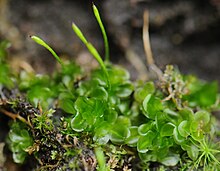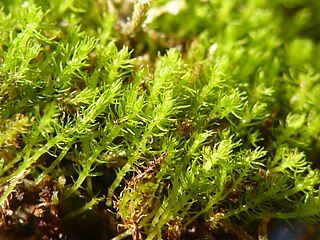
Takakia is a genus of two species of mosses known from western North America and central and eastern Asia. The genus is placed as a separate family, order and class among the mosses. It has had a history of uncertain placement, but the discovery of sporophytes clearly of the moss-type firmly supports placement with the mosses.
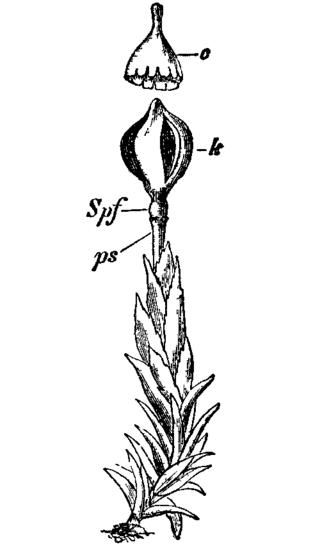
Andreaeaceae is a family of mosses which includes two genera, Andreaea, containing about 100 species, and the genus Acroschisma. The Andreaeaceae prefer rocky habitats ranging from tropical to arctic climates, on which they form tufted colonies, typically with reddish to blackish shoots. The capsules lack the peristome mechanism and dehisce longitudinally to release the spores, resulting in a paper-lantern appearance.
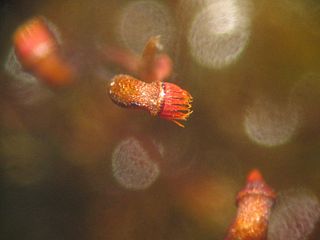
The Bryopsida constitute the largest class of mosses, containing 95% of all moss species. It consists of approximately 11,500 species, common throughout the whole world.

Buxbaumia is a genus of twelve species of moss (Bryophyta). It was first named in 1742 by Albrecht von Haller and later brought into modern botanical nomenclature in 1801 by Johann Hedwig to commemorate Johann Christian Buxbaum, a German physician and botanist who discovered the moss in 1712 at the mouth of the Volga River. The moss is microscopic for most of its existence, and plants are noticeable only after they begin to produce their reproductive structures. The asymmetrical spore capsule has a distinctive shape and structure, some features of which appear to be transitional from those in primitive mosses to most modern mosses.

Orthotrichaceae is the only family of mosses in the order Orthotrichales. Many species in the family are epiphytic.
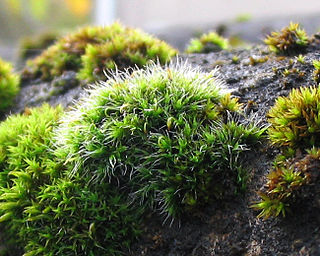
Grimmiales is an order of mosses in the subclass Dicranidae. It comprises four families: Grimmiaceae, Ptychomitriaceae, Seligeriaceae, and Saelaniaceae.

Sphagnopsida is a class of mosses that includes a single subclass Sphagnidae, with two orders. It is estimated it originated about 465 million years ago, along with Takakia. The order Sphagnales contains four living genera: Ambuchanania, Eosphagnum, and Flatbergium, which counts four species in total, and Sphagnum which contains the rest of the species. The extinct Protosphagnales contains a single fossil species.
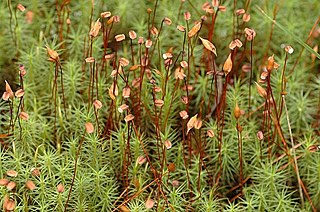
Polytrichaceae is a common family of mosses. Members of this family tend to be larger than other mosses with a thickened central stem and a rhizome. The leaves have a midrib that bears photosynthetic lamellae on the upper surface. Species in this group are dioicous. Another characteristic that identifies them is that they have from 32 to 64 peristome teeth in their sporangium.

The Funariidae are a widespread group of mosses in class Bryopsida. The majority of species belong to the genera Funaria and Physcomitrium.

Pottiales is an order of mosses in the subclass Dicranidae.

Seligeriaceae is a family of mosses in the subclass Dicranidae.
Andreaeobryum, the Mossy Cowl Moss, is a genus of moss with a single species Andreaeobryum macrosporum, endemic to Alaska and western Canada. The genus is placed as a separate family, order and class among the mosses.

Tetraphidaceae is a family of mosses. It includes only the two genera Tetraphis and Tetrodontium, each with two species. The defining feature of the family is the 4-toothed peristome.
Gigaspermaceae are a family of mosses in the monotypic order Gigaspermales. The order is placed in subclass Gigaspermidae of the class Bryopsida. They were previously placed in subclass Funariidae.

Encalyptales is an order of mosses in subclass Funariidae. It contains a single family.

Timmia is a genus of moss. It is the only genus in the family Timmiaceae and order Timmiales. The genus is named in honor of the 18th-century German botanist Joachim Christian Timm.

Fissidentaceae is a family of haplolepideous mosses (Dicranidae) in the order Dicranales, with a single genus, Fissidens. It was formerly placed in the now-obsolete order Fissidentales.
Neosharpiella is a genus of moss containing two species in the family Bartramiaceae. The type species, Neosharpiella aztecorum, grows in alpine regions of central Mexico, while the other species, Neosharpiella turgida, has been found in Bolivia and Ecuador.
Ptychomitriaceae is a family of mosses in the subclass Dicranidae.
William Russel Buck is an American bryologist.
